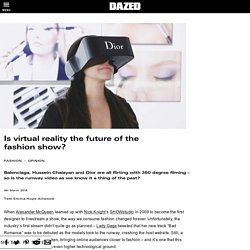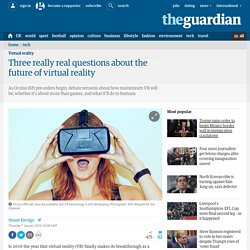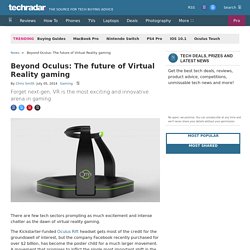

Virtual Reality Hits NYFW. NEW YORK, United States – Several designers at New York Fashion Week are enhancing the consumer experience they offer fans of their brands with realtime virtual reality (VR) experiences.

Members of the public will be able to view 13 shows — including Prabal Gurung, Misha Collection, Supima and Band of Outsiders — in VR, through an app, a virtual reality headset and a Samsung smartphone. Viewers will also be able to watch the same 13 shows in 2D on the official NYFW website and the designers’ own websites. In a separate announcement, designer Rebecca Minkoff revealed that she would debut her latest collection with a livestream VR experience, and offer her fans the ability to virtually shop a look straight off the catwalk using an app. Is virtual reality the future of the fashion show? When Alexander McQueen teamed up with Nick Knight’s SHOWstudio in 2009 to become the first designer to livestream a show, the way we consume fashion changed forever.

Unfortunately, the industry’s first stream didn't quite go as planned – Lady Gaga tweeted that her new track “Bad Romance” was to be debuted as the models took to the runway, crashing the host website. Still, a new frontier had been broken, bringing online audiences closer to fashion – and it’s one that this season is being pushed to even higher technological ground. 4 Reasons Why Fashion Brands Are Adopting Virtual Reality Co-authored by Averie Hah and Alan Shekhtman.

10 examples of virtual reality marketing in action. Thanks to the rise of more affordable, accessible and sophisticated headsets from Oculus Rift, virtual reality is becoming an incredibly immersive way for brands to engage consumers and customers.

Here, we highlight 10 recent examples of virtual reality in action during marketing campaigns and programs to see just how dynamic and creative usage can be. Hyundai’s virtual rally To coincide with the World Rally Championships in Italy this June, Innocean Worldwide Europe has launched a 4D Hyundai driving experience for visitors based on Oculus Rift technology. The co-driving simulator is aimed at engaging motor fans while raising awareness of Hyundai’s strong performance on the rally circuit, and gives participants the chance to feel what it’s like to be part of a rally car race.
Virtual destinations with Qantas Earlier this year, Qantas launched a pilot program testing out virtual reality goggles with first-class travellers in-flight and in its executive lounges. Crash testing with NRMA. 10 Examples of Augmented Reality in Retail. From shoppable windows to products that come alive in your hand; the worlds of augmented reality and retail have collided spectacularly in recent years.

The retail landscape is overcrowded and customers are becoming desensitized to traditional marketing methods. That’s where augmented reality comes in. As shoppers turn to a blend of online, mobile, and bricks-and-mortar shopping for their convenience, brands and retailers are having to think of new and innovative ways in which they can capture customer attention. Augmented reality – or AR – has the power to bring an image, product label or even shop window to life. Customers can see brands and their stock in a new way and engage with them on a completely new level. It’s creative, innovative, and it works. 1. Trying on clothes can be pretty off-putting for many shoppers, especially those in a hurry. 2. Image via I am Fabulicious 3. 4. Diamonds may be a girl’s best friend, but choosing the right ring for a loved one can be a difficult task.
What Is Virtual Reality? Virtual reality means creating immersive, computer-generated environments that are so convincing users will react the same way they would in real life.

The idea is to block out the sensory input from the outside and use the visual and auditory cues to make the virtual world seem more real. While the concept is simple, actually building virtual reality systems has proven difficult to do, until recently. "The big difference here is the sensory deprivation," says game developer Eric "Giz" Gewirtz, chief creative officer at Seismic Games in Los Angeles. "You're more susceptible to real life-like experience — on a very primitive level you're tuning everything out.
" Three really real questions about the future of virtual reality. Is 2016 the year that virtual reality (VR) finally makes its breakthrough as a mainstream technology?

That’s a question for its evangelists and sceptics to argue about, and there are plenty in both camps. With Facebook’s Oculus Rift headset now available to pre-order, Sony’s PlayStation VR and HTC’s Vive on their way, and millions of cheap Google Cardboard headsets out in the wild already, this year will see a barrage of experimentation around VR. Stepping back from the hype, there are three big questions – really real questions, you could say – about VR’s potential, and as the answers emerge in 2016, we’ll have a much better idea of whether this time round, the tech will be a hit or a flop.
How mainstream is this technology really going to be? “One day, we believe this kind of immersive, augmented reality will become a part of daily life for billions of people,” wrote Zuckerberg in March 2014, when he announced the acquisition. Beyond Oculus: The future of Virtual Reality gaming. There are few tech sectors prompting as much excitement and intense chatter as the dawn of virtual reality gaming.

The Kickstarter-funded Oculus Rift headset gets most of the credit for the groundswell of interest, but the company Facebook recently purchased for over $2 billion, has become the poster child for a much larger movement. A movement that promises to inflict the single most important shift in the way we experience videogames, since they moved from the arcade to the home. From start ups like Virtuix, Avegant and GameFace standing tall on the bleeding edge, to tech giants like Sony, Samsung and Google realising they must be on board, the movement is growing fast. Want PC gaming on the go? Check out the best gaming laptops While this year's E3 gaming expo in Los Angeles was supposed to be all about the games and what would justify an Xbox One or PS4 purchase, most attendees came away chatting about VR. Put your Game Face on Another of those companies is GameFace Labs. Game innovation.